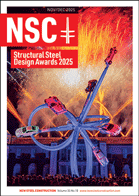SSDA Awards
AWARD – AELTC Indoor Tennis Centre, London
Topped with a tennis-racket inspired undulating roof, the Indoor Tennis Centre is the latest addition to the All England Lawn Tennis Club’s facilities.
FACT FILE
Architect: Hopkins Architects
Structural engineer: Cundall
Steelwork contractor: Billington Structures Limited
Main contractor: Willmott Dixon
Client: The All England Lawn Tennis Club
Part of the All England Club’s wider masterplan, the steel-framed Indoor Tennis Centre (ITC) accommodates six indoor courts and six outdoor courts, members’ family room and bar, dressing rooms and a basement car park.
Contributing to a more coherent campus (a tunnel under Somerset Road links it to the All England Club’s main estate), the ITC building is topped with an iconic double-curved undulating steel roof.
According to Hopkins Architects, the profile of the roof follows the space in which tennis is played, with high points over the centre of the nets (to account for lobs) and a reduced height over the runoffs around the court perimeters.
Controlled natural lighting and ventilation provide a perfect setting for uninterrupted play, while externally the building and clay courts are set seamlessly into its surroundings. The project has also included extensive landscaping, retaining the All England Club’s guiding principle of ‘Tennis in an English Garden’ throughout its grounds.
Overall, the roof measures approximately 110m-long × 50m-wide, with the latter incorporating the clear 38m spans required by the tennis courts.
Willmott Dixon’s Design Manager, Mat Trewin, says the biggest challenge associated with the steel-framed roof structure was the intricacy and coordination required to make it work, both in design and delivery.
To ensure the elegant, flowing aesthetic intent was achieved, it was vital that the steel frame, cladding and integrated services all fitted together seamlessly and consistently across the six indoor courts it encloses.
The geometry of the roof was constrained both internally by the playing volume requirements and externally by planning limitations on height, together with a desire to minimise the internal space to reduce the heating/cooling requirements.
“This resulted in a very limited zone for the structure, which naturally leant itself to a series of tied steel arches that provide strength and spanning ability without bulk, ensuring the elegance of the roof,” says Cundall Partner David Rivers.
“The use of the tied arches creates a balanced system that in turn reduces the forces applied to the supporting concrete frame, contributing to its sleek aesthetic, while helping to reduce embodied carbon.”
The tight tolerances, achievable with steelwork, also suited the design of the project, while the ability to fabricate and install millimetre precise sections ensured that the geometry of the roof, over each of the six courts, remained consistent.
According to steelwork contractor Billington Structures, the geometry and length of the curved spans, coupled with the aesthetic requirements for squared corners, meant the arches had to be formed with fabricated box sections (typically 500mm x 300mm sections). With varying degrees of curvature, the arches are connected together by a series of secondary beams.
A lot of workshop precision was needed to ensure each curved beam was identical and fabricated to the required high level of quality.
The long spans necessitated a splice, but to avoid the need for onsite welding at height, a hidden connection detail was developed. This allowed the members to be bolted together in thirds and maintained the appearance of one continuous steel member for each arch. To maintain stability during the build programme, temporary props were installed to support the steelwork.
The building’s permanent stability system has been discreetly designed and includes two movement joints, incorporated into the building’s length to manage thermal effects. Further stability is provided by cross bracing, hidden in the roof structure, which acts in combination with local portalisation and lateral connections to the concrete cores.
Besides the technical benefits, steelwork also forms a key part of the aesthetic of the roof, contrasting with the timber ceiling panels and providing visual interest to the structure.
Steelwork also allowed the roof to be spliced into smaller sections, aiding transport around the network of small local roads and reducing the temporary propping and crane sizes needed, allowing a logical and sequential installation sequence that shortened the overall erection period.
The ability to prefabricate these sections offsite also helped ensure the achievement of very tight and repetitive tolerances, ensuring consistency across all six courts despite the varying geometry in each span direction.
Sustainability was a key focus and aspiration for the project and a BREEAM ‘Very Good’ rating was achieved. A range of energy saving initiatives were utilised, including a natural ventilation system, heat pumps and PVs. The carpet tiles are 100% carbon neutral and the entrance mats are made of goat hair rather than plastic. During construction, schemes were put in place to ensure a large percentage of waste was diverted from landfill, which minimised transportation emissions.
The All England Club says this ambitious project aimed to deliver the best possible internal playing conditions, while providing a dual-purpose facility that meets both its year-round and Championships needs.
The volume and space created, alongside the uncluttered playing area, have been a resounding success, and the All England Club has received outstanding feedback from both Club members and professional players.
In summary, the judges say, the ITC, distinguished by its graceful double-curvature roof, is beautifully finished and an outstanding addition to the estate. Exposed structural steelwork enhances the interior, creating a striking and welcoming volume. Exemplary coordination between disciplines ensured refined detailing, resulting in a building of clarity and elegance.





